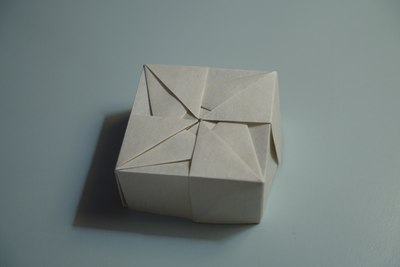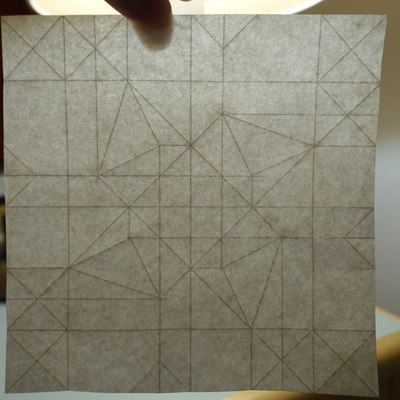John Gerard’s Pure Flax White Paper Review

Among the many attractions of the 2023 meeting of German Origami Society was the possibility to enjoy, once again after a three-year break, the great papers made by John Gerard paperworks. One interesting addition to the shop’s offer was a white, pure-flax paper. The color matters a lot here since flax-based papers have an intriguing property: they usually come in various shades of gray-brown, but the crease is white and stands out strongly against the uncreased paper. Thus, despite the very elegant looks and good folding properties, I have not used papers made primarily from flax much so far. Upon seeing the almost pure white sheet, I thought it would be worth a try since against such a color the crease should no longer stand out.
For the test (immediately the night between two convention days), I folded a ca. 20 cm square into a Box with Woven Triangles XVIII.

The paper is almost pure white, though compared to a sheet of plain copy paper, it appears slightly yellowish. The difference results from a different production process: the handmade sheet is not made white by using any dyes or whiteners, but by processing the raw flax/linen with hydrogen peroxide which removes the fibers’s natural color. Thus, the white color is actually the lack of other colors. Such white is not quite as bright as the white in mass-produced printer paper loaded with titanium dioxide, but the lack of additives makes the paper more stable and natural. Different shades of the gray-brown flax paper palette can be produced by mixing raw and processed flax fiber or linen rags in different proportions, and the resulting colors are all very elegant. The white in the pure white sheet not being extremely bright is actually beneficial from my point of view since very white models are difficult to photograph due to them being so bright and easily getting overexposed. The flax sheet looks quite well in the pictures despite the lighting being rather poor: just a desk lamp in my hotel room, and compared to anything apart from very bright white, its white color is certainly bright enough.

As is usual for hand-made papers, the surface was a little rough to the touch, but in a pleasant way. Precreasing went well, with no noticeable grain direction, and the creases were smooth and sharp. Most importantly, they were only as white as the paper around them, and were only visible as changes in texture rather than in color. In reflected light, they were not very noticeable, but stood out in good contrast when viewed in transmitted light. The paper was stiff despite being relatively thin (as expected from flax paper), and the collapse went well. I will have to try this paper on a larger model from a larger sheet, but results from this initial test fold are very satisfying.
Comments